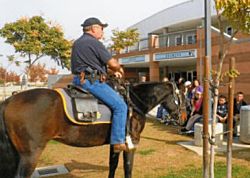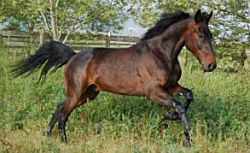Fresno Police Department use Standardbreds to fight crime
February 7, 2014,by Rich Fisher, USTA Web Newsroom Senior Correspondent

Rich Fisher
Trenton, NJ — Tom Parris has been in the racing business since 1969 and, at age 80, had to give up driving this year only because back surgery sidelined him last season.
He still serves as a trainer and has three horses he works with now.
If anyone knows about not being put out to pasture, it’s Parris. That is why he and his wife, Janet, are proud to contribute to the Fresno Police Department’s use of Standardbred horses to fight crime in central California.
They, and several others, have donated horses to the police shortly after their racing careers ended.

K D Judge, now known as Chief, is part of the Fresno Police Department’s use of Standardbreds to fight crime.
“It’s very frightful because of the danger, but I’m very grateful to Fresno,” Janet said. “I think it’s absolutely wonderful that they have taken horses off the track that are no longer able to race that are still very healthy, well-bred, well-cared-for horses and given them a new life.”
Tom and Janet have donated one of their own horses and placed two others from other owners with the FPD in recent years.
“They are strictly Standardbreds now, they won’t use anything but,” Tom said. “They’ve had Thoroughbreds and regular horses of some kind, but they didn’t work out the way Standardbreds do.”
And the difference is?
“Attitude,” Tom said. “Their demeanor is much better. Thoroughbreds are a little too high strung, that’s at least what they told me. And they just like the way the Standardbreds perform.”
Tom refers to himself as “sort of the liaison for (the police) for the other horses.” Listening to how he got involved is the classic friend-of-a-friend-of-a-friend story.
“I have a relative that lives in Fresno that is related to one of the women that volunteers with the police department,” Parris said. “They contacted me and I got some horses for them.”
Tom said that they are looking to keep the horses uniform in color and size “so you don’t get a little bitty one and a big one.” All the candidates have had racing experience.
Once they are donated, the police put them through their paces. And it isn’t easy.
“They have quite a regimen they have to go through,” Tom said.
The horses have to go up a ramp and jump into a pond of water, then walk to the other side. They are jogged over bubble wrap packing material to simulate the sounds of bullets shooting. They also have to remain calm with firecrackers going off.
They are walked over a teeter-totter to become acclimated to moving bridges. There is usually a big fan with moving balloons and objects blowing things around, to prepare for windy environments.
“They have to be able to stay calm under gun fire, which is why they shoot off the firecrackers and have the bubble wrap, to get them used to it,” Janet said. “One thing that’s interesting is, whoever the officer is riding the horse, he has to train them for guidance with his knees, because sometimes these officers have to have their hands free in order to use weapons.”
It usually takes around three months of training before the horses are ready to go out on patrol, or to be on standby at various functions where large crowds are expected. That is one of the reasons they want calm horses, because they are there to help in case a riot breaks out — not to cause one.

Photos courtesy of Willey Farm
K D Judge won five races in 51 career starts from 2004-2007.
Janet notes that the force’s favorite horse is a male who was renamed from K D Judge to Chief. A contest was held to decide the name. K D Judge was owned by Keith Willey of the Willey Standardbred Farm in Herald, Calif., which is where Tom has his horses.
Asked if he ever thought he would indirectly be helping fight crime, Tom chuckled.
“I never thought about it too much,” he said. “It’s a pretty good thing for the police to find them a home. And they really do take good care of them.”
